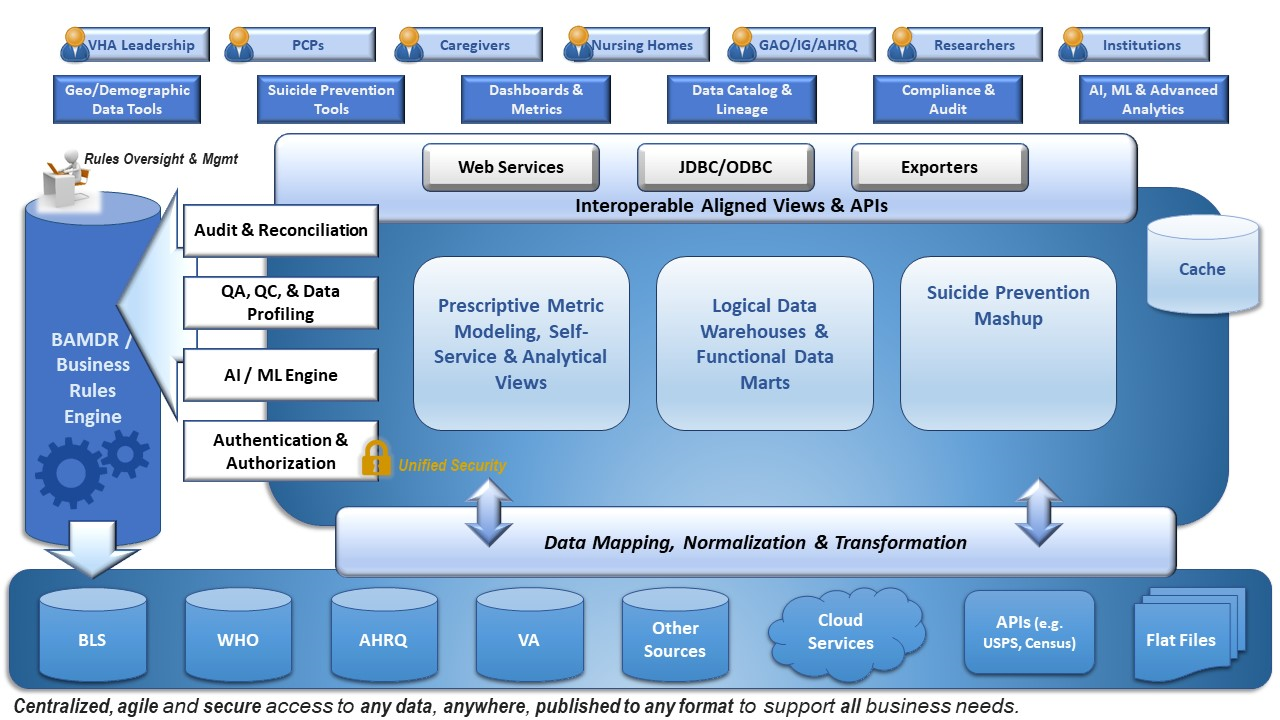Suicide Prevention Attestation Solution (SPAS)
Overview
SPAS is the Suicide Prevention Attestation Solution. It is the Interoperable, evidentiary approach to suicide prevention. It uses the latest applied methods of technology (e.g., Prescriptive Analytics, Data Virtualization, Extended Metadata, AI) and methods of collaboration to provide a holistic approach to rescue individuals from self-harm
Why do we believe this Solution will succeed where others have failed
- The information that needs to be captured for this solution either does not exist, is not governed, or is not used at all healthcare facilities and care sites.
- The solution can be used, either free of charge, or at little cost to Caregivers and Nursing Homes
- The number of data attributes needed for this solution is small, relatively speaking – the narrow scope of the project affords the ability to be agile in working with medical business partners to build interoperable data structures and relationships.
- The amount of disruption to a medical facility is minimal or non-existent.
- The solution provides a direct means of controlling costs and focus (e.g., suicide ideation, opioid abuse).
- It is expected that the speed to which the ‘actors’ will interact with each other will increase, whether dealing with suicide prevention/intervention, policy making, or research.
- The solution already has the framework to include Social Media to assist in suicide interventions.
- The solution contains a monitor that is used for continuous learning and continuous improvement.
- The solution can be used, either free of charge, or at little cost to Caregivers and Nursing Homes
- Known methods and solutions that have worked in other industries or for other VA healthcare clients will be repurposed as part of this solution.
What is innovative about our solution?
Flexibility
Our solution includes a methodology and the tools/training necessary to provide the following:
- Improved, agile compliance with suicide prevention protocols
- Includes novel medical governance-based approaches for complying with Congressional Suicide Prevention Bill S785
- Contains the framework to leverage AI and Machine Learning
- Compatibility with the vast array of EHR products, including Cerner, Epic, VisTA
- Can be implemented even if Care Sites are not using an EHR
- An implementation schedule that is independent of EHR modernization projects
- interoperability is provided across the entire spectrum of the Continuum of Care. Actors include community care and social media.
Establishes a foundation and springboard for leveraging AI/ML
The approach includes the identification and modeling of types of heuristics (e.g., Attentional, Availability, Representational), which conveys biases that may aid in understanding and mitigating suicide ideation. This information is harvested and can be used to develop treatment regimens that can address Cognitive Behavioral Therapies (CBTs)
Once these biases have been identified and agreed upon by clinicians, our subject matter experts analyze AI characteristics and implements prescriptive metrics, which serve as course corrections that can be used to understand and improve veteran and juvenile decision-making across the entire Continuum of Care (e.g., Emergency Rooms, Community Care, Acute Care Organizations).
Prescriptive Metrics
SPAS uses Prescriptive Metrics to ensure that suicide prevention models and protocols are followed, via Attestation/Affirmation — across the entire Continuum of Care and during Transitions in Care.
Data Virtualization
Data Virtualization is used to perform data transport and data mashups to achieve limited interoperability: Rescue from Self-Harm, as opposed to more expensive and time-consuming methods such as ETL and FHIR.
Data replication occurs rarely if at all.
Supports and facilitates Research
Our Subject Matter Experts can provide Data, in a variety of formats, in accordance to what is needed by institutions and research facilities.
How the SPAS works
- Data Virtualization is used to transport data between any of the data sources and sinks described in this document.
- The BAMDR is used to harmonize data sets by resolving the dissimilar characteristics (e.g., names, values, datatypes), aiding and facilitating interoperability.
- The Business Rules Engine is used to ascertain whether suicide prevention steps were followed and provide options when they are not followed.
- Suicide warning and prevention steps are obtained from a variety of authoritative organizations (e.g., VA, DOD, AHRQ).
- Demographic and geospatial information is captured to reflect socioeconomic factors associated with self-harm. For instance, the Bureau of Labor Statistics (BLS) provides an API for national financial/demographic data.
- Our team presents the actors with a mashup of the different protocols, with pros and cons
- Opportunities for interoperability and suicide prevention protocols for care sites are identified.
- Our team aids in the modeling of heuristics and artificial intelligence/machine learning constructs.
- Our team provides data architecture and governance support.
- Our team identifies areas and workflow steps that are a candidate for ‘affirmation’.
- Our team designs and implements prescriptive metrics objects with the care sites and researchers.
- Our team ensures that Prescriptive Objects are tested as they are deployed to Care Sites.
- Suicide Prevention Results Mashup is created. The Mashup provides an ongoing monitor of which protocols were followed, successful or needed improvement.
- Prescriptive Metrics to determine which suicide protocols were followed, which were not, and why , and provide attestation when they are followed
About the SPAS Diagram
The diagram that is depicted on this page was provided as a courtesy from the Genesis Professional Group. Genesis is solutions provider with decades of experience across a wide array of Industry Segments in Data Virtualization, AI/ML and architecture.
Genesis can be contacted at: genesisprofessionalgroup.com
